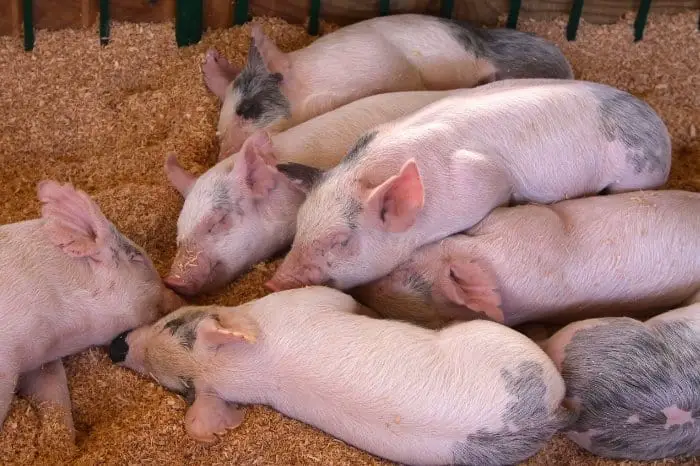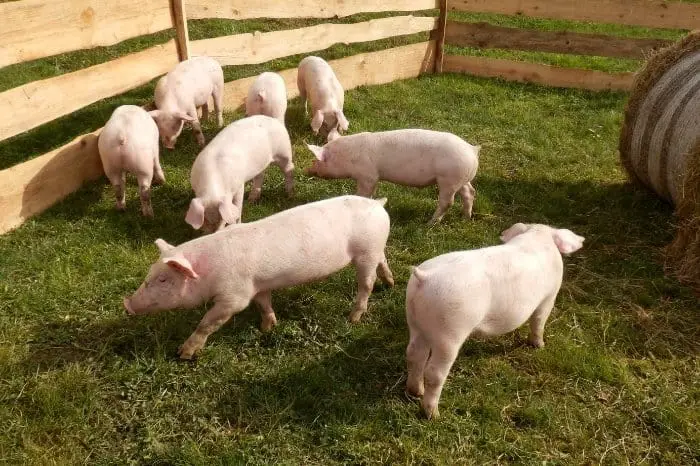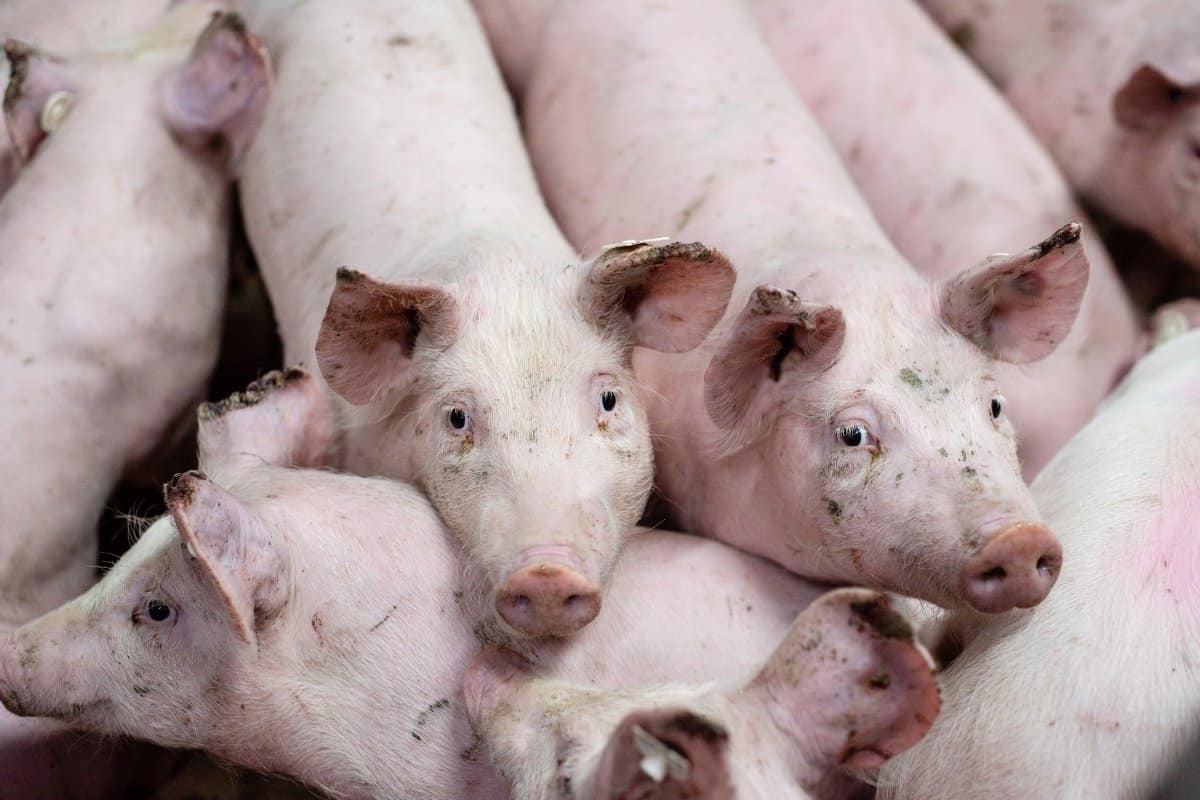Last Updated on February 8, 2022 by
Are you a pig farmer? What is a group of pigs called? And what is a litter of pigs called? Or are you among the many who do not know?
We will focus on pig rearing and management in this article and learn something new about groups of pigs.
Pig production is an adventure that most pig enthusiasts love to undertake. The excitement of watching these animals from the birth of a litter of many piglets is a frustrating journey to some and joyous to others.
Let’s share this truth right from the beginning – farming pigs is more challenging than farming other animals like goats and cattle. This is because pigs are more sensitive to the weather climate and require more attention.
On the other hand, if properly taken care of, a single saw can give birth to 12 piglets within a gestation period of 130 days. These piglets are usually ready for the market sooner than most livestock animals.
So To Start With, Let’s Learn What Is A Group Of Pigs Called?
All the groups are defined to help you understand what different herds of pigs are called. There you have it:
- Drove or drift is a group of pigs
- A litter is a group of young pigs
- A group of hogs is known as a team or passel
- A sounder is a herd of swine
- A group of boars is known as a singular.

Raising Group Of Pigs
There are many pig species throughout the world, and it is better to use local breeds because they have already adapted to the climate and are available within the area.
To rear pigs, it is better to start with piglets; focus on growing and selling them. The process of raising them will help you gain experience and develop management tactics.
Your management expertise will be sound since breeding is more complicated than rearing pigs.
Ways Of Rearing Pigs
Popularly pigs are farmed in a barn for intensive farming or a pasture for free-range.
-
Barn Or Intensive Farming
Make your pig barn with heat-resistant material like concrete. The feeding area should be about 3 meters wide, perfect for 2 pigs. The resting area should measure half the size of the feeding area. It should have a small pool for them to bathe.
-
The Pasture Or Free-range Farming
To farm pigs on free range, you will need a large area with plenty of grass and soil. The area needs to be fenced for the pigs to be secure and not roam too far. You will need to install a strong fence because adult pigs can damage the fence and escape.
-
Feeding And Watering Your Pigs
Feeding – It is highly essential to pick out a good feed for your pigs. Pigs must be fed on at least 18% of crude protein. Most pig farmers feed their pigs on table scraps and wastes, which are not suitable for these animals.
Pigs are omnivores, but it is not wise to feed them with these wastes. Feed them on plant materials like corn, lettuce, and other vegetables. It is not advisable to feed them meat as they will increase their body fat and decrease their growth and profit.
Feed your pigs on 6 to 10 kgs of feed per day to keep them growing healthy. Some farmers feed them with eggs and milk for their protein content.
Before starting your pig farm, ensure that you can afford to vaccinate and feed them until they are market-ready.
Watering – It is important to provide your pigs with ample water. Water is essential, yet many times it can be forgotten. A large supply of clean water is needed to maintain the pigs’ necessities. A growing young pig drinks approximately 10L of clean water each day, while an adult drinks about 25 to 50L per day.
You will need to have a reliable supply of clean drinking water available. In pig rearing, water is the forgotten nutrient because most farmers forget to provide adequate water. An unreliable supply of water leads to serious loss in productivity, poor mortality, and the breeding of diseases.
HiCamer Livestock Pig Waterer 304 Stainless Steel Body Farm Sow
It is advisable always to have clean drinking water in a storage tank to reserve at least 2 days of water if something goes wrong with the pump.
Read more about How Long Till Chickens Lay Eggs?
Do You Want To Breed Your Pigs?
Do you plan on breeding pigs or buying young ones to grow out and sell? First, choose to get some weaners and grow them out for the market a few times before attempting to breed them.
The growing process will give you hands-on experience and projection of costs. You will also get closer learning and understanding of pigs to help you develop the right management tools.
Once you have your management skills developed, you can start breeding a sow at a time. The process of breeding is more complicated than rearing weaners.
How To Keep Your Pigs Clean And Happy
Pigs are strong animals easy to raise but easily stressed by factors such as lack of enough food and water and severe weather effects if not housed properly.
The stress decreases productivity and might lead to the loss of animals. To protect this, provide your pigs with a solidly built infrastructure, including housing, fencing, and water troughs.

Poor management of pigs leads to disease that quickly spread and destroys your pig farming efforts. Pigs are susceptible to diseases that include diarrhea, especially if you have been overcrowding them.
Check Out The Best Rat Poison That Won’t Harm Other Animals
FAQs
How are pigs reared?
Pigs have been domesticated for more than 10,000 years and have become very important parts of many cultures as a rich source of protein. They are intelligent animals that are thought by some scientists to be smarter than dogs, and so people have developed a very close relationship with these animals within a farm environment.
Pigs aren't all raised the same way, bu they are rather raised in a number of different ways. The most common way is to rear them on pasture, where they are free to run around and graze.
In some parts of the world, pigs are fed on grain and kept in an enclosed space. This type of rearing is called intensive rearing. In Australia, most pigs are reared on pasture, but the country has a long tradition of intensive rearing as well.
How pigs are reared does affect the ultimate taste of the meat product that's derived from them. There is a strong belief that the happier the pig, the more natural it tastes.
Is pig farming cruel?
The answer is that it isn't cruel if it is done right by observant and responsible farmers who attend to the various needs of these wonderful creatures.
Pigs need to be fed regularly as they can get sick if they start to starve, and they must also be cleaned and groomed regularly to ensure that they don't catch anything. Responsible pig owners in a farm need to make sure their pig is always happy, healthy and content. Remember they are intelligent animals and as such require the proper stimulation in order to live happy and well-rounded lives. As well as this, pigs can get injured, so they must be treated quickly in the case that they are hurt. This is where the supervision comes in to play.
Pigs can even become aggressive at times, which means that they may need to be kept in a separate pen from the rest of your animals. This doesn't mean that there's something necessarily wrong with the health of the pig, but as complex animals they are all different and carry with them different personalities.
A pig’s diet should be varied, so that it gets all the nutrients and vitamins it needs to grow. Not providing them with a carefully selected diet is cruel as they can pretty easily become malnourished.
How do you pick out a healthy pig?
You might think that it would be quite hard to tell if a pig is healthy or not by just looking at it, but the truth of the matter is that you just have to know where to look.
When you're buying your pigs from the market, you should choose healthy looking ones with clear eyes and shiny coats as these are great indicators of their health.
You should ask questions about how the pig was cared for. Ideally, pigs should be fed a nutritious diet of grains, including corn, wheat and barley. This type of diet will give your pigs a healthy coat and help them to gain weight in a healthy and steady way.
Conclusion
FAQs
How are pigs reared?
Pigs have been domesticated for more than 10,000 years and have become very important parts of many cultures as a rich source of protein. They are intelligent animals that are thought by some scientists to be smarter than dogs, and so people have developed a very close relationship with these animals within a farm environment.
Pigs aren't all raised the same way, bu they are rather raised in a number of different ways. The most common way is to rear them on pasture, where they are free to run around and graze.
In some parts of the world, pigs are fed on grain and kept in an enclosed space. This type of rearing is called intensive rearing. In Australia, most pigs are reared on pasture, but the country has a long tradition of intensive rearing as well.
How pigs are reared does affect the ultimate taste of the meat product that's derived from them. There is a strong belief that the happier the pig, the more natural it tastes.
Is pig farming cruel?
The answer is that it isn't cruel if it is done right by observant and responsible farmers who attend to the various needs of these wonderful creatures.
Pigs need to be fed regularly as they can get sick if they start to starve, and they must also be cleaned and groomed regularly to ensure that they don't catch anything. Responsible pig owners in a farm need to make sure their pig is always happy, healthy and content. Remember they are intelligent animals and as such require the proper stimulation in order to live happy and well-rounded lives. As well as this, pigs can get injured, so they must be treated quickly in the case that they are hurt. This is where the supervision comes in to play.
Pigs can even become aggressive at times, which means that they may need to be kept in a separate pen from the rest of your animals. This doesn't mean that there's something necessarily wrong with the health of the pig, but as complex animals they are all different and carry with them different personalities.
A pig’s diet should be varied, so that it gets all the nutrients and vitamins it needs to grow. Not providing them with a carefully selected diet is cruel as they can pretty easily become malnourished.
How do you pick out a healthy pig?
You might think that it would be quite hard to tell if a pig is healthy or not by just looking at it, but the truth of the matter is that you just have to know where to look.
When you're buying your pigs from the market, you should choose healthy looking ones with clear eyes and shiny coats as these are great indicators of their health.
You should ask questions about how the pig was cared for. Ideally, pigs should be fed a nutritious diet of grains, including corn, wheat and barley. This type of diet will give your pigs a healthy coat and help them to gain weight in a healthy and steady way.
To sum it up, if you want to rear healthy pigs, be careful what breeds you buy to start your herd. Invest in good pigs – never buy pigs just because they are cheap. Poorly bred pigs may carry diseases, take longer to grow to a marketable size, or be genetically inferior.
They may also have poor meat to fat ratio or poor body conformation. Such a poor breed does not provide quality meat, and your market won’t be satisfied with such pork. This will affect you greatly as a pig farmer or supplier. To avoid all this, do your homework well before starting your drove.
Caroline is a gardener who loves to get down to the nitty–gritty of gardening. She proudly proclaims herself as a ‘dirt worshipper‘ and can often be found deep in the garden, covered in soil and singing to her plants. As a self–proclaimed ‘plant whisperer‘, Caroline believes that plants need love and attention just like any other living thing, and she loves to give them both. When she‘s not tending to her garden, you can often find her researching the latest gardening trends, or teaching others how to make their gardens thrive



